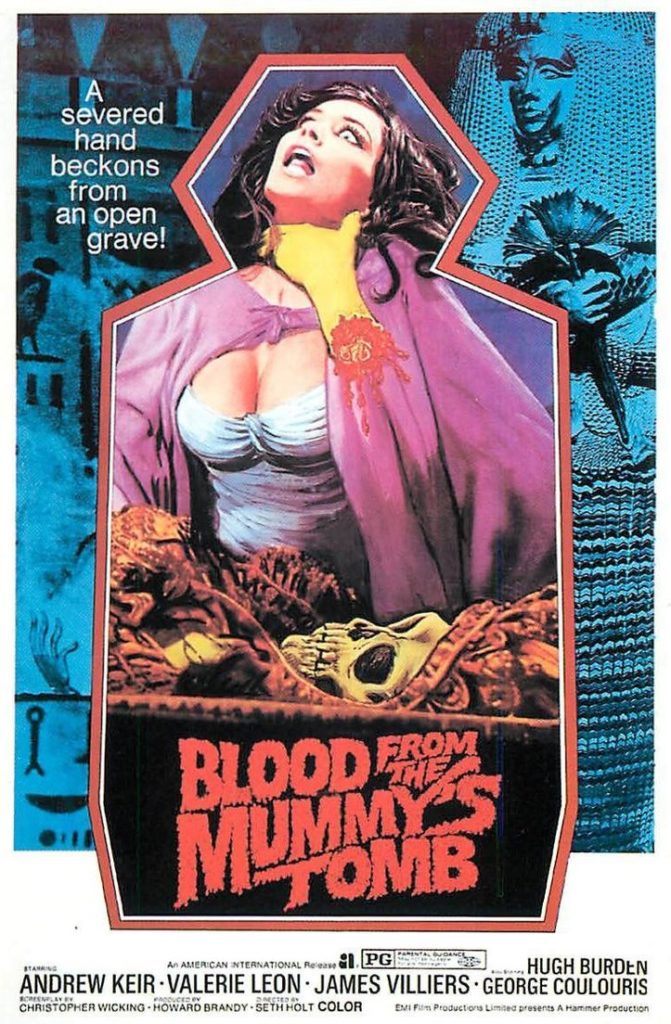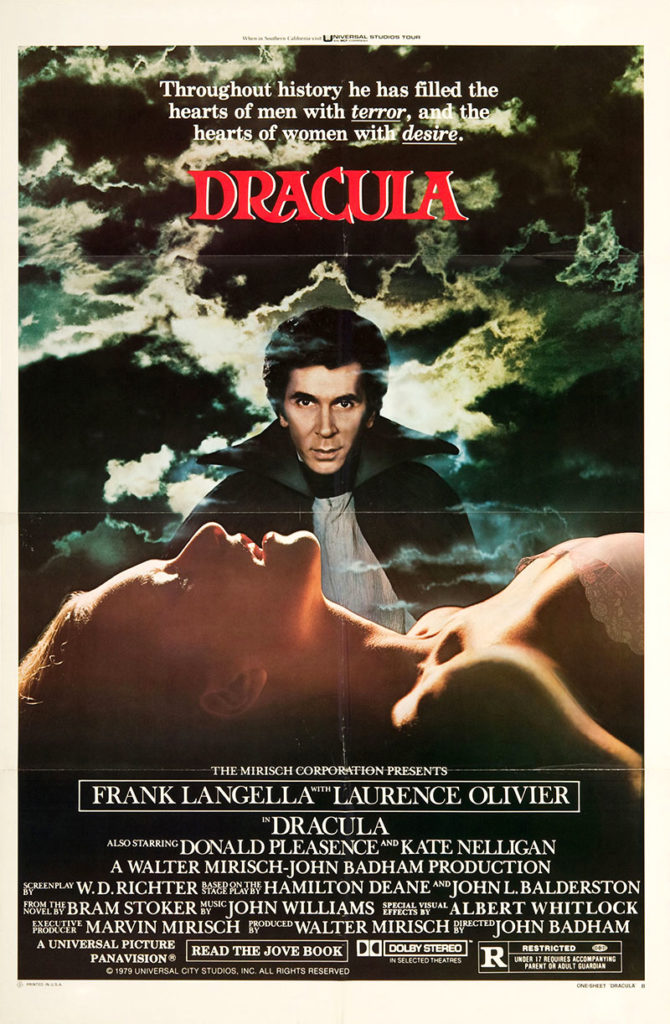There aren’t very many Hammer horror flicks that take place in contemporary times. For this month, only six of the films I’ve watched up to this point take place around the time in which they were filmed. Only one film from the franchise flicks, Blood from the Mummy’s Tomb, breaks away from its gothic setting. Until now. Continue reading “Dracula A.D. 1972”
Some of Those Responsible: Bram Stoker
Scars of Dracula
These Hammer Dracula films are showing serious signs of franchise fatigue. Scars of Dracula is the sixth film in the series, and I can’t be sure that anyone involved cared one whit about the project. Unlike the Frankenstein films, which had their ups and downs, there was still great care in producing a viable film. But Scars of Dracula looks and feels cheap. Continue reading “Scars of Dracula”
Taste the Blood of Dracula
What a title. Taste the Blood of Dracula. That’s a pretty good start for today’s horror film, before a single frame even goes by. From 1970, Taste the Blood of Dracula was written by Anthony Hinds, directed by Peter Sasdy, and features Christopher Lee returning to play Dracula. Continue reading “Taste the Blood of Dracula”
Blood from the Mummy’s Tomb, or, Underboob: The Movie
 Hammer, in a wise decision, jettisoned much of the tropes they had used in their previous Mummy films. For three consecutive productions, they had made basically the same film. British archaeologists discover ancient Egyptian tomb, said tomb has a curse on it, ancient Egyptian mummy resurrects and kills those who dared desecrate the tomb. It really was the same thing again and again. That was all well and good when they did it the first time, but by the last film, The Mummy’s Shroud, the plot was too familiar, and everyone involved seemed to be just going through the paces.
Hammer, in a wise decision, jettisoned much of the tropes they had used in their previous Mummy films. For three consecutive productions, they had made basically the same film. British archaeologists discover ancient Egyptian tomb, said tomb has a curse on it, ancient Egyptian mummy resurrects and kills those who dared desecrate the tomb. It really was the same thing again and again. That was all well and good when they did it the first time, but by the last film, The Mummy’s Shroud, the plot was too familiar, and everyone involved seemed to be just going through the paces.
The fourth film, Blood from the Mummy’s Tomb, stays true to only some of the core elements, going so far as to ditch the traditional bandages and rags of films past. In this film, written by Christopher Wicking, loosely adapting Bram Stoker’s novel The Jewel of Seven Stars, the mummy is the perfectly preserved corpse of Queen Tera, who died young and buxom, and thus couldn’t be wrapped in bandages, oh no.
Her tomb is discovered by the requisite British Egyptologists, but they bring the dead queen and her artifacts back to England in secret, rather than placing them in a museum or putting on a tour. That’s because, for reasons that are never adequately explained, some of the party wish to resurrect the queen, so she can rule again. Anyway, the resurrection part is kind of on the periphery, because in the meantime, Queen Tera has a doppelganger in Margaret Fuchs (Valerie Leon, who plays both Margaret and Tera), the daughter of the archaeological expedition’s leader, Julian Fuchs (Andrew Keir). She was born in England at the very moment Queen Tera’s sarcophagus was opened, revealing the scantily clad beauty within. Continue reading “Blood from the Mummy’s Tomb, or, Underboob: The Movie”
Dracula Has Risen from the Grave
It is now the halfway point of this year’s Horrorshow, and I’m enjoying watching all these classic Hammer horror flicks. But, watching them all close together like this means I’m more aware of when they are repeating themselves compared to watching them on a normal release schedule. For example, the three Mummy flicks I’ve reviewed so far this month have basically been the same film. There is still a good film to be made from the idea, but by The Mummy’s Shroud, I’m not sure the filmmakers were trying. Today’s film, Dracula Has Risen from the Grave, suffers from some of the same sort of creative malaise that doomed The Mummy’s Shroud. Continue reading “Dracula Has Risen from the Grave”
Dracula: Prince of Darkness
 After eight years, Dracula, the actual Dracula and not some misdirection with the title, is back in Hammer’s 1966 film Dracula: Prince of Darkness. 1958’s Dracula (Horror of Dracula in the US) is among the most well-known and revered of Hammer’s horror catalogue. It was also a moneymaker. So, for a company that was in the business to make a buck I find it surprising that it took Hammer eight years to put a sequel together. Part of the problem may have been Dracula’s recalcitrant star, Christopher Lee. He led a most interesting life, mingling with true giants on a regular basis. Sometimes it feels like he did all this cheap horror to pay the rent, but his heart was never really in it. Like many stars he often failed to do the decent thing and keep his mouth shut about a project after filming wrapped. Continue reading “Dracula: Prince of Darkness”
After eight years, Dracula, the actual Dracula and not some misdirection with the title, is back in Hammer’s 1966 film Dracula: Prince of Darkness. 1958’s Dracula (Horror of Dracula in the US) is among the most well-known and revered of Hammer’s horror catalogue. It was also a moneymaker. So, for a company that was in the business to make a buck I find it surprising that it took Hammer eight years to put a sequel together. Part of the problem may have been Dracula’s recalcitrant star, Christopher Lee. He led a most interesting life, mingling with true giants on a regular basis. Sometimes it feels like he did all this cheap horror to pay the rent, but his heart was never really in it. Like many stars he often failed to do the decent thing and keep his mouth shut about a project after filming wrapped. Continue reading “Dracula: Prince of Darkness”
Dracula (1958), aka Horror of Dracula
It has been over a hundred and twenty years since Bram Stoker’s groundbreaking vampire novel was published. In that time, the titular character of Dracula has been put to film dozens of times. Every generation gets its own version of the tale. There’s just something about Dracula. The genre of horror itself is drawn to the character like one of his hapless victims. One can be sure that no matter what kind of just fate befalls Dracula in these films, it is only a matter of time before he returns. Continue reading “Dracula (1958), aka Horror of Dracula”
Bram Stoker’s Dracula
Look at that title. Bram Stoker’s Dracula. Of all the cinematic interpretations of the classic horror tale, only this one has the original author’s name in the title. It’s a nice touch, and easily differentiates the film from all the others. But, if a viewer is like me, they will wonder if such a title isn’t a tiny bit disingenuous. When I think of this film, I think of it as Francis Ford Coppola’s Dracula. His vision, and his touch, both deft and clumsy, is so evident throughout that he has made the material his own. Mr. Stoker didn’t need to have his name attached (except for legal reasons, apparently). Continue reading “Bram Stoker’s Dracula”
Dracula (1979)
 I’ve seen hundreds of horror films. And I’ve seen more Dracula films than I can either count or name. But until recently, I had no idea that this version of the oft-filmed tale existed. This Dracula is so lost to the digital history of cinema that when I searched for it on IMDb, I had trouble locating its page. I have a hard time understanding why.
I’ve seen hundreds of horror films. And I’ve seen more Dracula films than I can either count or name. But until recently, I had no idea that this version of the oft-filmed tale existed. This Dracula is so lost to the digital history of cinema that when I searched for it on IMDb, I had trouble locating its page. I have a hard time understanding why.
Perhaps Dracula has been adapted for the silver screen so many times that there is a sense of fatigue surrounding the character. Certainly, once a viewer latches on to a particular film as their favorite, only a morbid fascination with the character would compel one to dig through the continuously growing pile of Dracula films looking for a hidden gem. But that’s precisely what this Dracula is.
From 1979, this Dracula is an adaptation of both Bram Stoker’s novel and a stage play that ran on Broadway. Reprising his role from the play is Frank Langella as Dracula — a tall, rugged charmer with a gigantic mane of David Copperfield hair. Alas, the 1970s. Director John Badham helmed a film that is quite a compression of the novel, but it’s also very lean. I can only guess that this leanness is a result of the film using a stage play as part of its source material. The necessities of film and stage require that a story with the scope and breadth of a novel has to be trimmed down to fit very real budgetary and physical constraints. The play, being a successful production, probably got the bulk of that work out of the way, leaving the film free to breathe back out a bit on what the play sucked inwards. Continue reading “Dracula (1979)”
